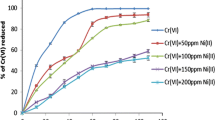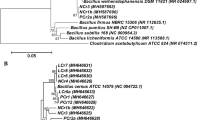Abstract
The potential role of parameters in the reduction of hexavalent chromium [Cr(VI)] by Pseudomonas aeruginosa is not well documented. In this study, laboratory batch studies were conducted to assess the effect of a variety of factors, e.g., carbon sources, salinity, initial Cr(VI) concentrations, co-existing ions and a metabolic inhibitor, on microbial Cr(VI) reduction to Cr(III) by P. aeruginosa AB93066. Strain AB93066 tolerated up to 400 mg/L of Cr(VI) in nutrient broth medium compared to only 150 mg/L of Cr(VI) in nutrient agar. This bacteria exhibited different levels of resistance against Pb(II) (200 mg/L), Cd(II) (100 mg/L), Ni(II) (100 mg/L), Cu(II) (100 mg/L), Co(II) (50 mg/L) and Hg(II) (5 mg/L). Cr(VI) reduction was significantly promoted by the addition of glucose and glycerine but was strongly inhibited by the presence of methanol and phenol. The rate of Cr(VI) reduction increased with increasing concentrations of Cr(VI) and then decreased at higher concentrations. The presence of Ni(II) stimulated Cr(VI) reduction, while Pb(II), Co(II) and Cd(II) had adverse impact on reduction ability of this strain. Cr(VI) reduction was also inhibited by high levels of NaCl, various concentrations of sodium azide and 20 mM of SO4 2−, MoO4 2−, NO3 −, PO4 3−. No significant relationship was observed between Cr(VI) reduction and redox potential of the culture medium. Scanning electron microscopy showed visible morphological changes in the cells due to chromate stress. Fourier transform infrared spectroscopy analysis revealed chromium species was likely to form complexes with certain functional groups such as carboxyl and amino groups on the surface of P. aeruginosa AB93066. Overall, above results are beneficial to the bioremediation of chromate-polluted industrial wastewaters.













Similar content being viewed by others
References
Aguilar-Barajas E, Díaz-Pérez C, Ramírez-Díaz M, Riveros-Rosas H, Cervantes C (2011) Bacterial transport of sulfate, molybdate, and related oxyanions. Biometals 24:687–707
Bae WC, Kang TG, Kang IK, Won YJ, Jeong BC (2000) Reduction of hexavalent chromium by Escherichia coli ATCC 33456 in batch and continuous cultures. J Microbiol 38:36–39
Bencheikh-Latmani R, Obraztsova A, Mackey MR, Ellisman MH, Tebo BM (2007) Toxicity of Cr(III) to Shewanella sp. strain MR-4 during Cr(VI) reduction. Environ Sci Technol 41:214–220
Bhattacharya A, Gupta A (2013) Evaluation of Acinetobacter sp. B9 for Cr(VI) resistance and detoxification with potential application in bioremediation of heavy-metals-rich industrial wastewater. Environ Sci Pollut Res 20:6628–6637
Bopp LH, Ehrlich HL (1988) Chromate resistance and reduction in Pseudomonas fluorescens strain LB300. Arch Microbiol 150:426–431
Brown SD, Thompson MR, VerBerkmoes NC, Chourey K, Shah M, Zhou J, Hettich RL, Thompson DK (2006) Molecular dynamics of the Shewanella oneidensis response to chromate stress. Mol Cell Proteomics 5:1054–1071
Cervantes C (1991) Bacterial interactions with chromate. Antonie Van Leeuwenhoek 59:229–233
Chatterjee Suparna GI, Mukherjea Kalyan K (2011) Uptake and removal of toxic Cr(VI) by Pseudomonas aeruginosa: physico-chemical and biological evaluation. Curr Sci India 101:645–652
Chen H, Li X, Xu Z (2011) Cr(VI) remediation by enriched sediment with anthraquinone-2,6-disulfonate as electron shuttles. Phys Chem Earth 36:451–454
Cheng Y, Yan F, Huang F, Chu W, Pan D, Chen Z, Zheng J, Yu M, Lin Z, Wu Z (2010) Bioremediation of Cr(VI) and immobilization as Cr(III) by Ochrobactrum anthropi. Environ Sci Technol 44:6357–6363
Cheung KH, Gu JD (2005) Chromate reduction by Bacillus megaterium TKW3 isolated from marine sediments. World J Microbiol Biotechnol 21:213–219
Das SK, Mukherjee M, Guha AK (2008) Interaction of chromium with resistant strain Aspergillus versicolor: investigation with atomic force microscopy and other physical studies. Langmuir 24:8643–8650
Das S, Mishra J, Das SK, Pandey S, Rao DS, Chakraborty A, Sudarshan M, Das N, Thatoi H (2014) Investigation on mechanism of Cr(VI) reduction and removal by Bacillus amyloliquefaciens, a novel chromate tolerant bacterium isolated from chromite mine soil. Chemosphere 96:112–121
Dogan NM, Kantar C, Gulcan S, Dodge CJ, Yilmaz BC, Mazmanci MA (2011) Chromium(VI) bioremoval by Pseudomonas bacteria: role of microbial exudates for natural attenuation and biotreatment of Cr(VI) contamination. Environ Sci Technol 45:2278–2285
Elangovan R, Philip L, Chandraraj K (2010) Hexavalent chromium reduction by free and immobilized cell-free extract of Arthrobacter rhombi-RE. Appl Biochem Biotechnol 160:81–97
Ertugay N, Bayhan YK (2008) Biosorption of Cr(VI) from aqueous solutions by biomass of Agaricus bisporus. J Hazard Mater 154:432–439
Essahale A, Malki M, Marin I, Moumni M (2012) Hexavalent chromium reduction and accumulation by Acinetobacter AB1 isolated from Fez tanneries in Morocco. Indian J Microbiol 52:48–53
Gabr RM, Hassan SHA, Shoreit AAM (2008) Biosorption of lead and nickel by living and non-living cells of Pseudomonas aeruginosa ASU 6a. Int Biodeterior Biodegrad 62:195–203
Gagrai MK, Das C, Golder AK (2013) Reduction of Cr(VI) into Cr(III) by Spirulina dead biomass in aqueous solution: kinetic studies. Chemosphere 93:1366–1371
Ganguli A, Tripathi A (1999) Survival and chromate reducing ability of Pseudomonas aeruginosa in industrial effluents. Lett Appl Microbiol 28:76–80
Ge S, Dong X, Zhou J, Ge S (2013) Comparative evaluations on bio-treatment of hexavalent chromate by resting cells of Pseudochrobactrum sp. and Proteus sp. in wastewater. J Environ Manage 126:7–12
Hsiao PQ, Shahir S, Liu T, Ahmad WA (2008) Determination of chromium(VI) reduction by Acinetobacter haemolyticus using X-ray absorption fine structure spectroscopy. J Fundam Sci 4:415–422
Kang SY, Lee JU, Kim KW (2007) Biosorption of Cr(III) and Cr(VI) onto the cell surface of Pseudomonas aeruginosa. Biochem Eng J 36:54–58
Li B, Pan D, Zheng J, Cheng Y, Ma X, Huang F, Lin Z (2008) Microscopic investigations of the Cr(VI) uptake mechanism of living Ochrobactrum anthropi. Langmuir 24:9630–9635
Liu YG, Xu WH, Zeng GM, Li X, Gao H (2006) Cr(VI) reduction by Bacillus sp. isolated from chromium landfill. Process Biochem 41:1981–1986
Llovera S, Bonet R, Simon-Pujol MD, Congregado F (1993) Chromate reduction by resting cells of Agrobacterium radiobacter EPS-916. Appl Environ Microbiol 59:3516–3518
Long D, Tang X, Cai K, Chen G, Shen C, Shi J, Chen L, Chen Y (2013) Cr(VI) resistance and removal by indigenous bacteria isolated from chromium-contaminated soil. J Microbiol Biotechnol 23:1123–1132
Lowe KL, Straube W, Little B, Jones-Meehan J (2003) Aerobic and anaerobic reduction of Cr(VI) by Shewanella oneidensis: effects of cationic metals, sorbing agents and mixed microbial cultures. Acta Biotechnol 23:161–178
Murugavelh S, Mohanty K (2012) Bioreduction of hexavalent chromium by free cells and cell free extracts of Halomonas sp. Chem Eng J 203:415–422
Murugavelh S, Mohanty K (2013) Isolation, identification and characterization of Cr(VI) reducing Bacillus cereus from chromium contaminated soil. Chem Eng J 230:1–9
Oves M, Khan MS, Zaidi A (2013) Chromium reducing and plant growth promoting novel strain Pseudomonas aeruginosa OSG41 enhance chickpea growth in chromium amended soils. Eur J Soil Biol 56:72–83
Ozturk S, Kaya T, Aslim B, Tan S (2012) Removal and reduction of chromium by Pseudomonas spp. and their correlation to rhamnolipid production. J Hazard Mater 231–232:64–69
Pal A, Paul AK (2004) Aerobic chromate reduction by chromium-resistant bacteria isolated from serpentine soil. Microbiol Res 159:347–354
Parker DL, Borer P, Bernier-Latmani R (2011) The response of Shewanella oneidensis MR-1 to Cr(III) toxicity differs from that to Cr(VI). Front Microbiol 2:1–14
Pei QH, Shahir S, Santhana Raj AS, Zakaria ZA, Ahmad WA (2009) Chromium(VI) resistance and removal by Acinetobacter haemolyticus. World J Microbiol Biotechnol 25:1085–1093
Poopal AC, Laxman RS (2009) Studies on biological reduction of chromate by Streptomyces griseus. J Hazard Mater 169:539–545
Puzon GJ, Roberts AG, Kramer DM, Xun L (2005) Formation of soluble organo-chromium (III) complexes after chromate reduction in the presence of cellular organics. Environ Sci Technol 39:2811–2817
Raja C, Anbazhagan K, Selvam G (2006) Isolation and characterization of a metal-resistant Pseudomonas Aeruginosa strain. World J Microbiol Biotechnol 22:577–585
Sayel H, Bahafid W, Tahri Joutey N, Derraz K, Fikri Benbrahim K, Ibnsouda Koraichi S, El Ghachtouli N (2011) Cr(VI) reduction by Enterococcus gallinarum isolated from tannery waste-contaminated soil. Ann Microbiol 62:1269–1277
Shen H, Wang YT (1994) Biological reduction of chromium by E. coli. J Environ Eng 120:560–572
Tahri Joutey N, Bahafid W, Sayel H, Ananou S, El Ghachtouli N (2014) Hexavalent chromium removal by a novel Serratia proteamaculans isolated from the bank of Sebou River (Morocco). Environ Sci Pollut Res 21:3060–3072
Thacker U, Parikh R, Shouche Y, Madamwar D (2007) Reduction of chromate by cell-free extract of Brucella sp. isolated from Cr(VI) contaminated sites. Bioresour Technol 98:1541–1547
Tripathi AGA (2002) Bioremediation of toxic chromium from electroplating effluent by chromate-reducing Pseudomonas aeruginosa A2Chr in two bioreactors. Appl Microbiol Biotechnol 58:416–420
Tunali S, Kiran I, Akar T (2005) Chromium(VI) biosorption characteristics of Neurospora crassa fungal biomass. Miner Eng 18:681–689
Villegas LB, Pereira CE, Colin VL, Abate CM (2013) The effect of sulphate and phosphate ions on Cr(VI) reduction by Streptomyces sp. MC1, including studies of growth and pleomorphism. Int Biodeterior Biodegrad 82:149–156
Wang YT, Shen H (1997) Modelling Cr(VI) reduction by pure bacterial cultures. Water Res 31:727–732
Wang YT, Xiao C (1995) Factors affecting hexavalent chromium reduction in pure cultures of bacteria. Water Res 29:2467–2474
Xu WH, Liu YG, Zeng GM, Li X, Song HX, Peng QQ (2009) Characterization of Cr(VI) resistance and reduction by Pseudomonas aeruginosa. T Nonferr Metal Soc 19:1336–1341
Zakaria ZA, Zakaria Z, Surif S, Ahmad WA (2007) Hexavalent chromium reduction by Acinetobacter haemolyticus isolated from heavy-metal contaminated wastewater. J Hazard Mater 146:30–38
Zhang K, Li F (2011) Isolation and characterization of a chromium-resistant bacterium Serratia sp. Cr-10 from a chromate-contaminated site. Appl Microbiol Biotechnol 90:1163–1169
Acknowledgments
This research was financially supported in part by the National Natural Science Foundation of China (Grant Nos. 41273122, 41073058 and 40973075), and in part by Research Fund for the Doctoral Program of Higher Education of China (No. 20100172110028).
Author information
Authors and Affiliations
Corresponding author
Rights and permissions
About this article
Cite this article
Kang, C., Wu, P., Li, Y. et al. Estimates of heavy metal tolerance and chromium(VI) reducing ability of Pseudomonas aeruginosa CCTCC AB93066: chromium(VI) toxicity and environmental parameters optimization. World J Microbiol Biotechnol 30, 2733–2746 (2014). https://doi.org/10.1007/s11274-014-1697-x
Received:
Accepted:
Published:
Issue Date:
DOI: https://doi.org/10.1007/s11274-014-1697-x




